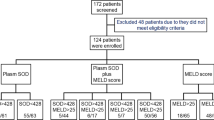Abstract
Background
Oxidative stress has been suspected to influence graft survival and prognosis in pediatric recipients of living related liver transplantation (LRLT).
Purpose
We determined the oxidative status of pediatric LRLT recipients during their regular outpatient follow-up visits, and looked for a relationship between oxidative status and post-liver transplantation (post-LTx) duration.
Patients
The study included 43 patients (20 males and 23 females) between the ages of 1.6 and 25.1 years (median 10.7 years) who had undergone LRLT from 5 months to 17.5 years (median 7 years) prior to the study, between the ages of 1.2 and 14.4 years (median 3.5 years).
Methods
Serum glutamic pyruvic transaminase (GPT), glutamic oxaloacetic transaminase (GOT), gamma-glutamyl transpeptidase (γ-GTP), alkaline phosphatase (ALP), lactate dehydrogenase (LDH), direct bilirubin and choline-esterase were measured as part of the patients’ regular follow-up visits. Serum total hydroperoxide (TH) and biological antioxidative potential (BAP) were measured using the free radical analytic system which requires 20 μl of serum and 10 min of processing time for each sample. Oxidative stress index (OSI) was calculated as the ratio of TH to BAP.
Results
Serum OSI correlated positively with serum levels of GOT, GPT, LDH, ALP, γ-GTP and direct bilirubin. Serum OSI, TH, LDH, ALP and GOT correlated negatively with post-LTx duration. Serum BAP correlated positively with post-LTx duration. Serum TH correlated positively with serum GOT and γ-GTP, but negatively with serum BAP.
Conclusions
(1) The OSI, which can be calculated based on data acquired through a simple outpatient procedure, can serve as an index of our patients’ laboratory results and oxidative status. (2) The LRLT recipients in our study were at risk for oxidative stress early in the post-operative period, but this risk subsided with time.


Similar content being viewed by others
References
Loguercio C, Federico A (2003) Oxidative stress in viral and alcoholic hepatitis. Free Radic Biol Med 34:1–10
Busuttil RW, Tanaka K (2003) The utility of marginal donors in liver transplantation. Liver Transpl 9:651–663. doi:10.1053/jlts.2003.50105
Hussein MH, Daoud GA, Kakita H, Hattori A, Murai H, Yasuda M, Mizuno K, Goto K, Ozaki Y, Ito T, Tanaka T, Fukuda S, Kato I, Fujimoto S, Suzuki S, Sobajima H, Togari H (2007) The sex differences of cerebrospinal fluid levels of interleukin 8 and antioxidants in asphyxiated newborns. Shock 28:154–159. doi:10.1097/shk.0b013e31803dcf55
Dohi K, Satoh K, Ohtaki H, Shioda S, Miyake Y, Shindo M, Aruga T (2005) Elevated plasma levels of bilirubin in patients with neurotrauma reflect its pathophysiological role in free radical scavenging. In Vivo 19:855–860
Halliwell B, Gutteridge JM, Cross CE (1992) Free radicals, antioxidants, and human disease: where are we now? J Lab Clin Med 119:598–620
Taylor BL, Watts KJ, Johnson MS (2007) Oxygen and redox sensing by two-component systems that regulate behavioral responses: behavioral assays and structural studies of Aer using in vivo disulfide cross-linking. Methods Enzymol 422:190–232. doi:10.1016/S0076-6879(06)22010-X
Cerecetto H, Lopez GV (2007) Antioxidants derived from vitamin E: an overview. Mini Rev Med Chem 7:315–338
Parola M, Robino G (2001) Oxidative stress-related molecules and liver fibrosis. J Hepatol 35:297–306
Hultqvist M, Olsson LM, Gelderman KA, Holmdahl R (2009) The protective role of ROS in autoimmune disease. Trends Immunol 30:201–208. doi:10.1016/j.it.2009.03.004
Li Volti G, Basile F, Murabito P, Galvano F, Di Giacomo C, Gazzolo D, Vadala S, Azzolina R, D’Orazio N, Mufeed H, Vanella L, Nicolosi A, Basile G, Biondi A (2008) Antioxidant properties of anesthetics: the biochemist, the surgeon and the anesthetist. Clin Ther 159:463–469
Andreadis AA, Hazen SL, Comhair SA, Erzurum SC (2003) Oxidative and nitrosative events in asthma. Free Radic Biol Med 35:213–225
Yamanaka G, Kawashima H, Suganami Y, Watanabe C, Watanabe Y, Miyajima T, Takekuma K, Oguchi S, Hoshika A (2006) Diagnostic and predictive value of CSF d-ROM level in influenza virus-associated encephalopathy. J Neurol Sci 243:71–75. doi:10.1016/j.jns.2005.11.029
Rosser BG, Gores GJ (1995) Liver cell necrosis: cellular mechanisms and clinical implications. Gastroenterology 108:252–275
Albano E (2008) Oxidative mechanisms in the pathogenesis of alcoholic liver disease. Mol Aspects Med 29:9–16. doi:10.1016/j.mam.2007.09.004
Denk H, Stumptner C, Fuchsbichler A, Zatloukal K (2005) Alcoholic and non-alcoholic steatohepatitis. Verh Dtsch Ges Pathol 89:137–143
Cotler SJ, Kallwitz E, TenCate V, Bhushan A, Berkes J, Benedetti E, Layden-Almer J, Layden TJ, Valyi-Nagy T, Guzman G (2007) Diabetes and hepatic oxidative damage are associated with hepatitis C progression after liver transplantation. Transplantation 84:587–591. doi:10.1097/01.tp.0000279003.40279.0e
Diamond DL, Jacobs JM, Paeper B, Proll SC, Gritsenko MA, Carithers RL Jr, Larson AM, Yeh MM, Camp DG 2nd, Smith RD, Katze MG (2007) Proteomic profiling of human liver biopsies: hepatitis C virus-induced fibrosis and mitochondrial dysfunction. Hepatology 46:649–657. doi:10.1002/hep.21751
Geetha A, Lakshmi Priya MD, Jeyachristy SA, Surendran R (2007) Level of oxidative stress in the red blood cells of patients with liver cirrhosis. Indian J Med Res 126:204–210
Author information
Authors and Affiliations
Corresponding author
Rights and permissions
About this article
Cite this article
Hussein, M.H., Hashimoto, T., Daoud, G.AH. et al. Oxidative stress after living related liver transplantation subsides with time in pediatric patients. Pediatr Surg Int 27, 17–22 (2011). https://doi.org/10.1007/s00383-010-2721-3
Published:
Issue Date:
DOI: https://doi.org/10.1007/s00383-010-2721-3




